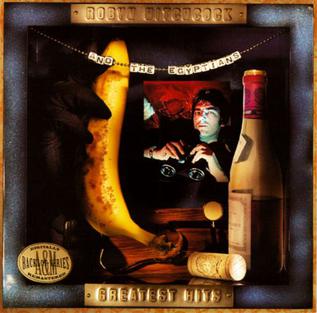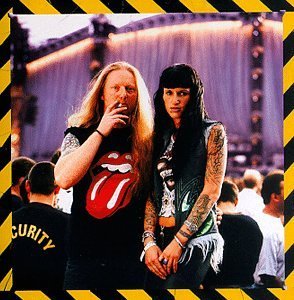
U2 got themselves a big hit by going back to the basics, so their next album was built from the same approach. And once again, while
How To Dismantle An Atomic Bomb played it safe, perhaps they played it a little too safe.
“Vertigo” was the best choice for both album opener and single, with a driving beat and a count-in that translates as “some, two, three, fourteen.” (The closing vocal does remind us of Paul Shaffer, however.) The sweeter “Miracle Drug” builds to a big chorus featuring the same drum patterns that drove “Beautiful Day”. Another tug at the heartstrings comes with “Sometimes You Can’t Make It On Your Own”, written for Bono’s dad’s funeral. This one also starts deceptively quietly, but really builds to its chorus. “Love And Peace Or Else” is a bombastic yet hollow threat, but “City Of Blinding Lights” nicely brings back some of their mid-‘80s vibe via Edge’s matching piano and guitar parts.
“All Because Of You” is another attempt at a big anthem with big Who chords, but you have to get past that percussive effect at the beginning that sounds like Fred Flintstone running across his living room. The mostly acoustic “A Man And A Woman” brings to mind the lesser half of the last album, and the lyrics are just plain wimpy. “Crumbs From Your Table” is a little better, a good arrangement masking a dark subject. The mildly atmospheric “One Step Closer” discusses death again, but it’s not clear what “Original Of The Species” is about, except three or so musical ideas shackled together. “Yahweh” is an imperfect prayer that would be more effective if Bono hadn’t come up with a better chorus than the title; besides, he’s written enough psalms already. Yet with that, the album simply stops.
How To Dismantle An Atomic Bomb has its moments, and it’s not “bad” in the slightest, but again, the ingredients weren’t adding up to something great. After decades of writing anthems it seems they feel every song has to be one. Somehow no fewer than six—six!—producers were credited on the album, from the stalwart Steve Lillywhite, Brian Eno, Daniel Lanois, and Flood to newer entrants (for them) Chris Thomas and Jacknife Lee. Maybe they didn’t want to leave any era untapped?
The album, of course, was a huge hit, no doubt helped by the subsequent tour. Coinciding with its release, the boys partnered with Apple Computers to market their own branded iPod, preloaded with a “digital box set” called The Complete U2. As the title would suggest, it included each of their albums, as well as every single, B-side, bonus track and EP. Of course, that meant that some songs got repeated across several singles, album tracks and hits collections, and any other rare tracks yet to be unveiled would be missing. But what made it especially enticing were the true rarities: a disc each of Early Demos and Unreleased & Rare tracks, a CD’s worth of selections from a 1997 concert in Mexico City dubbed Hasta La Vista Baby!, and two complete concerts. Live From The Point Depot was the band’s last appearance before they regrouped to record Achtung Baby, while Live From Boston 1981 was a fantastic club show that fueled some early B-sides and deserves to be available on its own.
Oddly, when it came time for the album’s 20th anniversary, not all of the Atomic Bomb outtakes included in The Complete U2 were included in the deluxe edition. Instead, along with one disc of remixes and two discs dedicated to the audio from the Vertigo 2005 – Live From Chicago DVD, the non-U.S. extra track “Fast Cars” was stuck at the end of the album, and a disc titled How To Re-Assemble An Atomic Bomb presented what they called a “shadow album” of outtakes. It’s actually a mostly decent set of tunes, and too bad that it’s only available in the pricey box. “Picture Of You” was previously known as “Xanax And Wine” (hence the “X+W” subtitle) and is a more rocking version of what would become “Fast Cars”. “Evidence Of Life” has a wonderfully trashy riff and echoes of their earliest albums, but the real gem is “Luckiest Man In The World”, once known as “Mercy” when it was performed live and released on an EP. “Treason” is a collaboration with Dave Stewart of Eurythmics, with some hip-hop elements and a choir from Ghana. “I Don’t Want To See You Smile” was previously known by the last word in its title, and an improvement. “Country Mile” has a classic Edge guitar sound and an anthemic arrangement that was probably too close to “Beautiful Day” to be included on the original album. “Happiness” can’t decide if it wants to be punk or dance, though it does include more mentions of the omnipresent atomic bomb. “Are You Gonna Wait Forever” was a “Vertigo” B-side, while “Theme From The Batman” was Edge’s contribution for that animated television show. “All Because Of You 2” is merely an alternate version of the album track. Hindsight being everything, some of these would have been more welcome on the original album than what did make it.
U2 How To Dismantle An Atomic Bomb (2004)—3
2024 20th Anniversary Edition: same as 2004, plus 45 extra tracks
 For some reason, which couldn’t have possibly included trying to capitalize on another label’s success, A&M decided it was time to put out a Greatest Hits album in the wake of the Rhino reissue program and Moss Elixir. Some of the more obvious choices from Globe Of Frogs, Queen Elvis, Perspex Island, and Respect are nicely intermingled with various B-sides from the same period that may have eluded the casual fan.
For some reason, which couldn’t have possibly included trying to capitalize on another label’s success, A&M decided it was time to put out a Greatest Hits album in the wake of the Rhino reissue program and Moss Elixir. Some of the more obvious choices from Globe Of Frogs, Queen Elvis, Perspex Island, and Respect are nicely intermingled with various B-sides from the same period that may have eluded the casual fan. The five or so years he was on A&M were somewhat fruitful for Robyn, so while this album did something of a service when the albums were deleted, Greatest Hits is only available via download, hovering this material just above limbo. Considering that the rest of his ‘80s catalog has been reissued twice with bonus tracks, it would be nice if someone, anyone, could authorize new versions of the four A&M albums, if only so new fans can more easily obtain such lost classics as “Balloon Man”, “Madonna Of The Wasps”, “So You Think You’re In Love” and “The Wreck Of The Arthur Lee”, to name just a few. And if they could also collect some of the other rare tracks from the period… (No dopes when it came to marketing, soon afterwards Rhino put together their own “hits” collection, made up of album tracks from the material they then owned. Some odd choices sat alongside some clever ones, likely compiled from somebody’s personal mix tape, and including no rarities.)
The five or so years he was on A&M were somewhat fruitful for Robyn, so while this album did something of a service when the albums were deleted, Greatest Hits is only available via download, hovering this material just above limbo. Considering that the rest of his ‘80s catalog has been reissued twice with bonus tracks, it would be nice if someone, anyone, could authorize new versions of the four A&M albums, if only so new fans can more easily obtain such lost classics as “Balloon Man”, “Madonna Of The Wasps”, “So You Think You’re In Love” and “The Wreck Of The Arthur Lee”, to name just a few. And if they could also collect some of the other rare tracks from the period… (No dopes when it came to marketing, soon afterwards Rhino put together their own “hits” collection, made up of album tracks from the material they then owned. Some odd choices sat alongside some clever ones, likely compiled from somebody’s personal mix tape, and including no rarities.)






